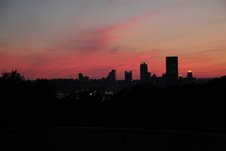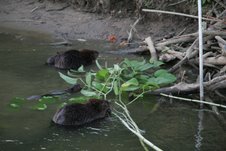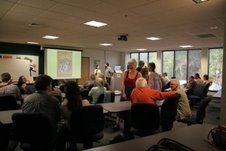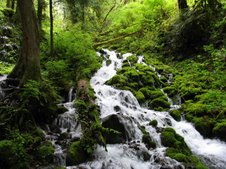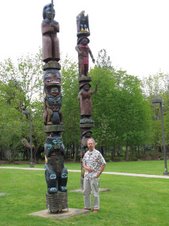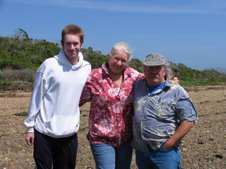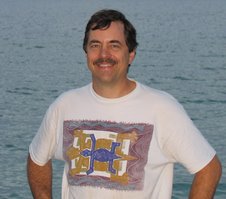Indigo was on the last 400 miles on the U.S. walk and on the last part of the European walk through Greece. She is Water's sister in Pittsburgh. In giving us a tour of their home, we were enthralled by a family of beavers who had made their home along the Allegheny River not far from downtown, a sign that water quality had improved. The air quality had also significantly improved in the past 20-30 years. Pittsburgh is now a leader in green building. During a quiet moment, I had a chance to talk with Indigo about the walks and her life.
“The U.S. walk was a major marker in my life," she said. "It came at a time when my whole life changed in 1984. By the time I made the decision to go on the walk at the end of September, my sister had died and my marriage had ended, so it was perfect timing. It was an empowerment exercise for me. I could walk by my own steam any place. I needed to change, to move, and the fact that I could walk 400 miles was empowering me, putting wind in my sails. Every day that I walked strengthened that. I had been familiarized with community through my visit to Findhorn in 1982, and I had been involved in a sweat lodge circle in Philadelphia, so all those components had me ready for the walk. It was an easy transition—I had a brother on the walk and the walk was pretty together by then. The walkers were all individuals, but they challenged themselves to work together.”
Highlights for Indigo after the walk included traveling to the Soviet Union with a group of artists in 1990 as part of a vision by Raisa Gorbachev and finding a flyer on the street in South Philly that advertised a sacred dancing event before the Great Pyramid in Egypt. “The dance opened a gateway that will remain open until 2011,” she said. “Eleven dances are supposed to occur by then and eight have been done so far. Each one has a certain tone associated with them. Had 130 people from 35 countries participate in the last dance. It’s been my spiritual driver. In the meantime, there were missions like with Water’s spiritual teacher. His mission was to have this peace dance. He saw what I was doing. Did a dance in 1993 and had people native to Ecuador come to do a dance. Purpose—opens a gateway to consciousness either evolutionary or to lay in certain energies. Each gate has a certain tone and energy. What attracts me is its movement with people from all over the world and we come together and work together and it seems like things change. If we love and trust one another, things get better. This group makes this be a focus. It’s not like it’s a religion or a movement, more a way of being.” For more information on the dances, log onto www.nvisible.com.
For her day job, Indigo works as an environmental educator focusing on responsible energy use in homes and businesses. She creates and implements education programs for grades 4 through 12.
To end the East Coast tour, we had a wonderful event at the Quest Bookshop in Charlottesville, Virginia. Our hosts were my adopted sister Ana Aegis (formerly Ann Clothiaux) and her partner Paul. Ana had participated in our 3-week walk in the Pacific Northwest in the late 1990s. It was great to see them and to roam around this progressive and attractive small city in the shadow of the Shenandoahs.
Thursday, July 5, 2007
Wednesday, July 4, 2007
Water Saudauskas: "The hardest step is out the front door"
In Pittsburgh, we stayed with former walkers Water Saudauskas and Indigo Raffel and held three gatherings with diverse and warm people. In the first gathering, one sweat leader named Johnny sang a sweat song for the group. I later spoke with Water about the walk and what he’s been doing since. “Highlights for me on the walk was gaining the ability after about a month to walk 18 miles and knowing that it was doable and easy, enabling me to become a migratory spiritual animal. Walking enabled me to enter the room of earth balancing where prior I was just knocking at the door, so that I could touch without any repercussions a wild rattlesnake. People we met thought we were doing things that they thought were impossible to them, but in talking with them they realized they could do it—it just takes practice. It is step by step, inch by inch. The hardest step is out the front door.”
Early in the morning during our stay, before dawn, Water left his house to visit a nearby park to “walk into the mystery of the forest.” Water added, “I don’t think I would have that gift without the walk. People use the word balance, to walk in balance, usually in books. I know in my guts and in the soles of my feet what that means because of the walk. I know that I can access it when I do walk.”
What are the highlights of Water’s life since the walk? “I held my father when he was dying so I received a vision that I hope I can manifest in my lifetime; sweating and working to humble myself for ten years with a Mexican-American Buddha-like Vietnam Vet named Luciano Perez; working with my emotionally devastated brother for the last 22 years in Pittsburgh. He’s a lot better because of that. Living in a transitional interracial neighborhood where walking and praying is a survival technique, not something that has an exercise value. It’s a way of living here to survive. In 2000, a mentally-ill African American man went on a killing spree, consciously killing three non-African American people and wounding two. To heal the torn interracial neighborhood, the churches two weeks later had a peace walk that drew 500 people to start to heal the wounds from this man on the community.
“On October 25th, 2001, I stood on Broadway looking into the smoldering hole of 911 praying with seven others that healing would go on. Through the walk and the spiritual discipline of Luciano Perez I had a sense of wonder and respect. The walk started me in arriving there, 17 years later.
“I’m almost 59 now. I don’t have a car, so I use my legs and ride buses. Walking helps me keep sane; that’s correlated to the walk. The walking grounds me so that I don’t put out the fear vibrations to the animals.”
Early in the morning during our stay, before dawn, Water left his house to visit a nearby park to “walk into the mystery of the forest.” Water added, “I don’t think I would have that gift without the walk. People use the word balance, to walk in balance, usually in books. I know in my guts and in the soles of my feet what that means because of the walk. I know that I can access it when I do walk.”
What are the highlights of Water’s life since the walk? “I held my father when he was dying so I received a vision that I hope I can manifest in my lifetime; sweating and working to humble myself for ten years with a Mexican-American Buddha-like Vietnam Vet named Luciano Perez; working with my emotionally devastated brother for the last 22 years in Pittsburgh. He’s a lot better because of that. Living in a transitional interracial neighborhood where walking and praying is a survival technique, not something that has an exercise value. It’s a way of living here to survive. In 2000, a mentally-ill African American man went on a killing spree, consciously killing three non-African American people and wounding two. To heal the torn interracial neighborhood, the churches two weeks later had a peace walk that drew 500 people to start to heal the wounds from this man on the community.
“On October 25th, 2001, I stood on Broadway looking into the smoldering hole of 911 praying with seven others that healing would go on. Through the walk and the spiritual discipline of Luciano Perez I had a sense of wonder and respect. The walk started me in arriving there, 17 years later.
“I’m almost 59 now. I don’t have a car, so I use my legs and ride buses. Walking helps me keep sane; that’s correlated to the walk. The walking grounds me so that I don’t put out the fear vibrations to the animals.”
Tuesday, July 3, 2007
Suzanne Carlson: Beating Swords into Plowshares
Cyndi and I drove to Greenfield, Massachusetts to meet with walk veteran Suzanne Carlson and four members of the Kumik intertribal Native American group. We exchanged sacred tobacco and other gifts and had an inspirational discussion for about three hours. Nearby was an historic village site, now on an island in a reservoir, that they said was a sacred place of peace where people of many tribes could meet in safety for trade and rest. Colonists massacred the village inhabitants in the 1600s and the Kumik group does healing ceremonies on the anniversary of the massacre. Their leader is a clear-eyed woman named Strong Oak.
I also interviewed Suzanne, who was on the cross-continental walk. Walk highlights for her included being able to come together in community, gorgeous scenery, climbing into the Sierra mountains, hot springs, connecting with a peace pilgrimage of Europeans, the gathering with the Kaibab Paiutes, Wounded Knee, meeting Glenda Banks and several Native American runners returning from the Jim Thorpe Run, West Virginia’s cranberry bogs, and many other places and events. “The walk gave me a closer connection to the earth,” she said, “and a sense of how out of balance this culture is. We have to learn the wisdom of the elders, especially in valuing the commons and the community above one’s egocentric needs and desires.”
Through a connection with a man named Leo, who was on the walk for the first couple of days, Suzanne learned about the plowshares actions against the nuclear war machine. The group’s name is derived from the biblical concept of beating swords into plowshares. Suzanne eventually participated in a plowshares action, one that involved hammering on a trident missile tube and pouring blood on it. As a result, she served 11 months in prison in Alderson, West Virginia. “I had lots of support while in prison,” she says. “That was my statement of saying no to weapons and yes to life.”
Since the walk, Suzanne has also worked at a homeless shelter and on an organic farm. She currently works at a food coop in Greenfield and is still active in many causes, especially in promoting sustainability on a local level.
I also interviewed Suzanne, who was on the cross-continental walk. Walk highlights for her included being able to come together in community, gorgeous scenery, climbing into the Sierra mountains, hot springs, connecting with a peace pilgrimage of Europeans, the gathering with the Kaibab Paiutes, Wounded Knee, meeting Glenda Banks and several Native American runners returning from the Jim Thorpe Run, West Virginia’s cranberry bogs, and many other places and events. “The walk gave me a closer connection to the earth,” she said, “and a sense of how out of balance this culture is. We have to learn the wisdom of the elders, especially in valuing the commons and the community above one’s egocentric needs and desires.”
Through a connection with a man named Leo, who was on the walk for the first couple of days, Suzanne learned about the plowshares actions against the nuclear war machine. The group’s name is derived from the biblical concept of beating swords into plowshares. Suzanne eventually participated in a plowshares action, one that involved hammering on a trident missile tube and pouring blood on it. As a result, she served 11 months in prison in Alderson, West Virginia. “I had lots of support while in prison,” she says. “That was my statement of saying no to weapons and yes to life.”
Since the walk, Suzanne has also worked at a homeless shelter and on an organic farm. She currently works at a food coop in Greenfield and is still active in many causes, especially in promoting sustainability on a local level.
Subscribe to:
Posts (Atom)

